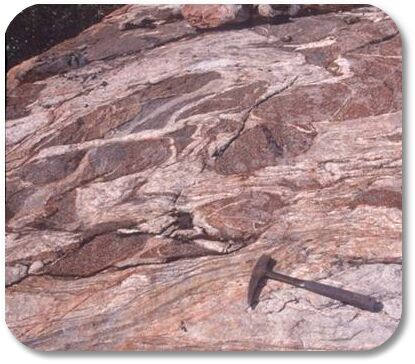Introduction
The ‘Kheisian’ fabric is an early phase of the Mesoproterozoic evolution of the Namaqua-Natal Belt. Graben formation with associated extrusion of lavas and deposition of sediments of the Koras Group occurred relatively early in the history of the Belt, predating most of the intrusive granitoid activity evident in other sub-provinces. Early, juvenile, dominantly mafic to intermediate Mesoproterozoic igneous units formed at  1.2–1.3 Ga in the Gordonia and Natal sub-provinces. The Little Namaqualand Suite intruded at 1.2–1.3 Ga in the Gordonia and Natal sub-provinces. The Little Namaqualand Suite intruded at  1.15 Ga in the Bushmanland sub-province, as did various individual plutons in the Gordonia and Natal sub-provinces. Spektakel, Keimoes and Oribi Gorge Suite granitoids, often megacrystic in character, were emplaced at 1.15 Ga in the Bushmanland sub-province, as did various individual plutons in the Gordonia and Natal sub-provinces. Spektakel, Keimoes and Oribi Gorge Suite granitoids, often megacrystic in character, were emplaced at  1.03– 1.03– 1.08 Ga. These latter granitoid suites each span several structural terranes, indicating that accretion of these domains was essentially complete by 1.08 Ga. These latter granitoid suites each span several structural terranes, indicating that accretion of these domains was essentially complete by  1.03 Ga. Igneous activity as part of the Namaqua-Natal orogenesis was concluded by 1.03 Ga. Igneous activity as part of the Namaqua-Natal orogenesis was concluded by  1.0 Ga throughout the belt. It is made up of supracrustal rocks, granitic gneisses and Kheisian metaquartzites. 1.0 Ga throughout the belt. It is made up of supracrustal rocks, granitic gneisses and Kheisian metaquartzites.
Source: Evolution of the Namaqua-Natal Belt, southern Africa – A geochronological and isotope geochemical review by B.M. Eglington (2006)
Geohydrology
•
|
Older granites have better water potential, due to higher erosion of structure. If erosion is deeper than water table, likelihood of water very high.
|
•
|
Water in schists and fractures in granites. If weathering is deeper than water table, good yields.
|
•
|
NW Cape and Western Transvaal –gneiss (metamorphic banded quartzite). Water common on fault zones. Dip of fault zones important.
|

|